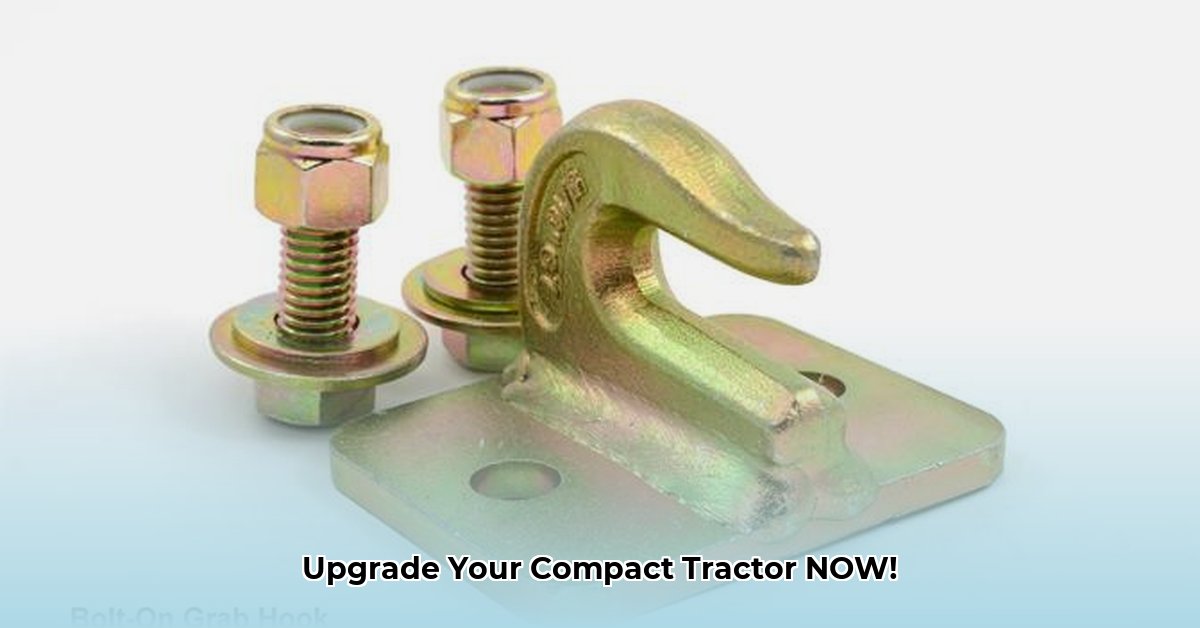
This comprehensive guide provides step-by-step instructions for selecting, installing, and maintaining bolt-on bucket hooks for your compact tractor. We'll cover crucial aspects to ensure safe and efficient operation, from understanding weight capacities to performing routine maintenance. For more information on compact tractors, check out this helpful resource.
Selecting the Right Bolt-On Bucket Hooks
Choosing the right hooks is paramount for safety and efficiency. Several factors influence your decision:
Weight Capacity and Material Strength
The most critical factor is the hook's weight capacity, often expressed as a Working Load Limit (WLL). This specification indicates the maximum weight the hook can safely lift. Always compare the hook's WLL to your tractor's lifting capacity, as listed in your owner's manual. Exceeding either limit is extremely dangerous. Grade 70 steel is a common and robust material choice for these hooks, offering excellent strength and durability. However, other materials may be suitable depending on your specific needs and budget. Think of it like selecting the right tool for a job; a flimsy hook for heavy lifting is a recipe for disaster.
Compatibility and Design Features
Ensure the hooks are compatible with your tractor's bucket and attachment points. Carefully check the manufacturer's specifications to confirm compatibility. Look for features like safety latches, which provide additional security, acting as "seatbelts" for your load. Consider the hook’s design; some offer additional attachment points (D-rings) for increased versatility, while others feature specialized designs suited for particular tasks.
Manufacturer's Warranty and Reviews
A comprehensive warranty shows confidence in the product's quality. Read reviews from other users to gain insights into real-world performance and durability. These reviews often highlight potential issues or strengths that manufacturer specifications might miss.
Installing Your Bolt-On Bucket Hooks: A Step-by-Step Guide
Proper installation is crucial for a strong and secure connection that prevents accidents. Follow these steps meticulously:
Prepare the Mounting Surfaces: Thoroughly clean the mounting areas on both the bucket and the hook, removing all dirt, rust, and paint. This ensures a firm grip and prevents compromised strength. Imagine building a house on an unstable foundation – it won't stand!
Align the Hooks: Carefully align the hook with the mounting holes on your bucket. Precise alignment is essential for a secure and stable fit. Take your time; rushing this step can lead to significant issues.
Bolt Installation: Insert the correct bolts provided with your hook set. Using incorrect bolts compromises the structural integrity and can lead to failure. Double-check bolt size and type against the manufacturer's instructions.
Tightening the Bolts: Tighten the bolts evenly, referring to the manufacturer's torque specifications. Use a torque wrench to ensure that you achieve the correct tightening force; overtightening can damage the hook or bucket. Striking a balance between sufficient tightness and preventing damage is key.
Test the Installation: Before lifting anything heavy, gently test the hook's connection. A slight rocking or wiggling suggests a loose connection and needs immediate attention.
Maintaining Your Compact Tractor Bucket Hooks: Essential Practices
Regular maintenance is key to ensuring the longevity and safety of your hooks.
Regular Inspections: Frequently inspect your hooks for signs of wear, damage, loose bolts, or corrosion. A visual inspection takes only minutes but significantly reduces the risk of failure.
Lubrication: Lubricate moving parts to prevent corrosion and reduce friction. This simple step significantly extends the hooks' lifespan.
Immediate Replacement: Replace any damaged hooks immediately. Compromised hooks pose a significant safety hazard and should never be used.
Troubleshooting Common Problems
Despite careful attention, issues can arise. Here's how to address common problems:
Poor Fit: Double-check that you have the correct hook for your bucket type and size. You might need a different model.
Loose Connections: Check and retighten loose bolts. If bolts are stripped or damaged, replace them.
Broken Hook: This usually indicates either exceeding the weight limit or a manufacturing defect. Replace the hook immediately and contact the supplier if you suspect a manufacturing defect.
Remember, safety is paramount. Regular inspections, proper installation, and adherence to weight limits are crucial for preventing accidents and ensuring the efficient operation of your compact tractor. Invest in high-quality hooks, follow these guidelines, and you’ll be confidently moving materials for years to come.